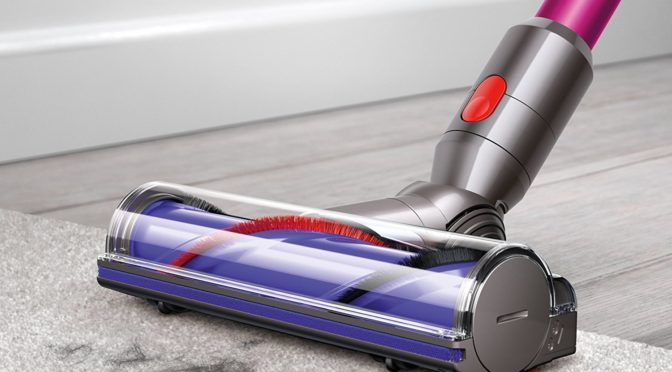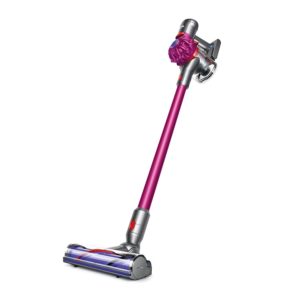
There are many times in life where convenience is more important than pure power. When you’re waiting in line at the DMV you’re not going to reach for a laptop; you’re going to pull out a smart phone (or an e-reader or “book”, if you’re particularly well read). And when it comes to vacuums, even though you’re going to get more power from an upright or canister than you will from a portable or robotic vacuum, sometimes it’s more important to have a tool that makes cleaning feel more fun and less like work.
Dyson gets this. They get it so well they’ve got a vacuum for (seemingly) everything. Want full power? Try the Ball Animal 2. Want a handheld? Here’s the V7 Car+Boat. And if you want a stick vacuum that can do both, they’ll sell you the V8 Absolute, which we recently reviewed and found to live up to its hype. Today we’re going to review the Dyson V7 Motorhead Cord-Free Vacuum and see how it stacks up to the V8 Absolute that succeeded it. If we had to summarize our thoughts in ten seconds, we’d suggest buying the Absolute for more battery life, more suction, and more accessories, and sticking to the V7 if you want a more minimal setup. Our full review is below, and you can buy the V7 Motorhead here.
Pros, Cons, and Key Features of the Dyson V7 Motorhead Cordless Vacuum
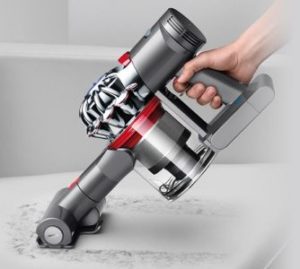
The Dyson V7 Motorhead is one of more than a dozen Dyson portables you can choose from, and is a mid-level previous-generation model in the cordless lineup. Dyson refers to their high-end portables as “cordless” or “cord-free” vacuums and calls their low-end portables “handheld.” The differences are primarily in better battery life in the cordless line and an extension hose you can use to turn them into stick vacuums. The top cordless is the V8 Absolute while the top handheld is the V7 Car+Boat. Other cordless-series vacuums include the V8 Animal, V6 Absolute, V6 Motorhead, and V6 Cord-free.
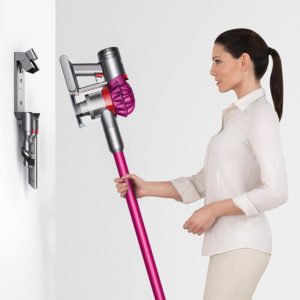
The V7 Motorhead’s key features include 30 minutes of runtime (19 minutes with the direct drive cleaner head, 6 minutes on max power mode), more suction than the V6 line, three accessories, a wall-mounted charging dock, and Dyson’s 2 year parts and labor warranty. The Motorhead weighs 5.5 pounds on our scale and can generate up to 100 airwatts of suction. The dust bin holds .14 gallons of dirt and you’ll need 3.5 hours to fully charge the included fade-free Lithium-ion battery.
Inside the box, you’ll find the Motorhead itself and three cleaning tools–a direct drive cleaner head, which is the most useful of the three, a quick release combination tool, and a quick release crevice tool. You’ll also get the docking station to charge and store the V7.
What’s the difference between the Dyson V7 Motorhead and the V8 Absolute?
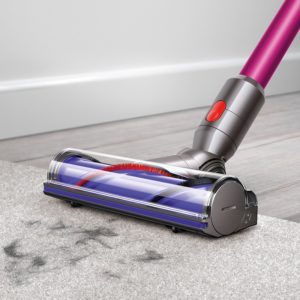
When we reviewed the V8 Animal and compared it to the Absolute, we noted that there was only one key difference: a soft roller cleaner head that came with the Absolute but not the Animal. There are many more differences between the Absolute and the V7 Motorhead, mostly centered around battery life, suction, filtration, and accessories. We’ll take a look at them more closely.
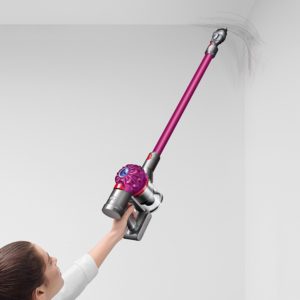
First, battery life. You get 30 minutes with the V7, but you get 40 minutes, or 33% more, with the V8. While this might not sound like much, it was enough to make a significant difference in how often we felt we “finished” a cleaning job vs. had to leave something undone (e.g., a car interior, a bedroom, a flight of stairs, etc). The difference was also reflected in battery life when using the motorized head, which dropped from 25 minutes in the V8 to 19 minutes in the V7. We also lost 2 minutes in max power mode, dropping from 8 minutes in the V8 to 6 in the V7.
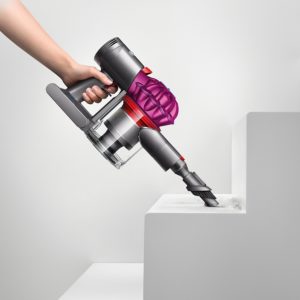
The second big difference was in suction. The V8 provides up to 115 airwatts while the V7 caps out at 100 airwatts. Functionally, this meant we didn’t need to make as many passes over Cheerios and cat hair to suck them up with the V8 as we did with the V7. Considering the fact that battery power is already limited in the V7 compared to the V8, every minute we spent recleaning with the V7 that we could have spent cleaning elsewhere with the V8 added up significantly. We sometimes felt like we weren’t getting any more power out of the V7 than we would from one of Dyson’s new handhelds–the V7 Car+Boat in particular. We realized we were right when we compared their suction figures: they’re both rated at 100 airwatts.
The third difference was minor to us, but if you have allergies, it might be a big one–the V8 comes with whole HEPA filtration, while the V7 doesn’t.
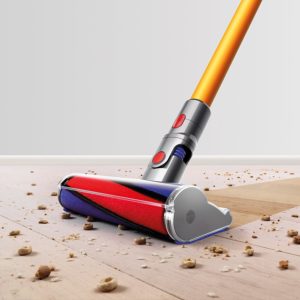
Finally, the V8 came with several more accessories than the rather meager set in the V7. Beyond the direct drive cleaner head, combination tool, and crevice tool, it also includes a soft roller cleaner head, a mini motorized tool, and a mini soft dusting brush. The soft roller head was particularly missed, as it allowed us to effectively clean bare floors (e.g., hardwood) without using the motorized head, which meant we could still maintain our 30 minute battery runtime. Similarly, the mini motorized tool was particularly helpful when tackling upholstery in handheld mode. Removing both reduced our productivity significantly.
Beyond these differences, the Motorhead is slightly lighter at 5.6 pounds than the Absolute at 5.8, and they come in different colors–a gold extension hose for the Absolute and a fuscia hose for the Motorhead. Practically speaking, the weight difference is one you’ll only notice if you stand on a scale while holding each machine.
How well will the Dyson V7 Motorhead clean up after dirt, kids, and pets?
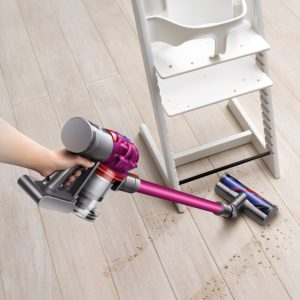
When you buy a cordless or stick vacuum, you’ve got to keep your expectations in check. It’s not a full-sized upright like the Ball Animal 2, and it’s not going to clean like one. It isn’t going to power through high-pile carpets like a Miele C1 Cat & Dog or Electro+ either; it’s a Dyson, but it still respects the rules of physics.
That said, we still found it capable of cleaning pet food, kid food, pet hair, kid hair, dust bunnies, and all kinds of other icky things from bare surfaces and a range of upholstered ones, including car seats, couches, and every minivan, SUV, or car you can fit in your garage. The main disappointments we noticed were the ones we mentioned earlier: the battery life felt a bit short at 30 minutes, especially since we knew 40 minutes was possible in the V8 generation. We also wanted more accessories for more cleaning flexibility and to make better use of what battery power we had. And finally, we’d like a shorter charging time than 3.5 hours. In a world where fancy robot vacuums like the Roomba 960 and 890 charge themselves in 2-3 hours, we’d like to see that technology in a Dyson someday. And for our friends with allergies, we’d like HEPA filtration.
Why buy the Dyson V7 Motorhead?
If the Motorhead were the latest cordless vacuum Dyson released, we’d love it. It’s ergonomic, easy to use, reasonably powerful, and offers a decent battery life. But in a world where the V8 Absolute and Animal exist for a comparable price, we find it hard to recommend the Motorhead. The Absolute gives more battery life, more suction, far more accessories, and HEPA filtering. The Animal, which we briefly mentioned above, gives you all you’ll get in the Absolute except for the soft roller head. Either would be a better use of your money than the Motorhead. That said, it’s still going to clean well, and if you don’t need the additional features, it might be the vacuum of your dreams.
![]() You can buy the Dyson V8 Absolute vacuum here on Amazon. If you don’t need the soft roller head, you can buy the V8 Animal here instead. If you’re hopelessly in love with the V7 Motorhead, you can buy it here.
You can buy the Dyson V8 Absolute vacuum here on Amazon. If you don’t need the soft roller head, you can buy the V8 Animal here instead. If you’re hopelessly in love with the V7 Motorhead, you can buy it here.
![]() Canadians can buy the Dyson V8 Absolute vacuum here on Amazon or save some money with the V8 Animal here instead. If you insist on the V7 Motorhead, you can buy it here.
Canadians can buy the Dyson V8 Absolute vacuum here on Amazon or save some money with the V8 Animal here instead. If you insist on the V7 Motorhead, you can buy it here.
 If you find our research on PMC helpful, you can follow our efforts to keep maniacally reviewing home cleaning tools by shopping through our links above. We promise to keep fighting the good fight against every horror children, animals, and grown, yet messy humans can inflict upon a clean home.
If you find our research on PMC helpful, you can follow our efforts to keep maniacally reviewing home cleaning tools by shopping through our links above. We promise to keep fighting the good fight against every horror children, animals, and grown, yet messy humans can inflict upon a clean home.

